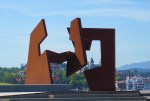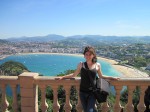Since I’ve been here at Pamplona, my experience has sort of splintered into five areas, based on my interests and situation. These are basically the five ‘lives’ I want to lead here, the things I want to explore. Of course, I won’t be fully immersed in any of them if I split up my time, but life is short and I want to taste as many things as possible. 🙂 These are not exactly equal to each other – they vary in terms of my motivation, the time and energy I will put into them, etc, but they’re all things I look forward to experiencing this semester.
1.) The Spanish Experience
Well, I don’t think I could get out of this one if I wanted to – it’s basically my default experience here. And it’s awesome. I’m taking all but one of my classes in Spanish, living with a Spanish woman, and making a few Spanish friends too, so I’m hoping to improve my knowledge of the language and the culture (both with a capital and a lowercase c). I love my province, Navarra, but I’m also very interested in exploring as much as I can of the rest of Spain – I’ve already been to Barcelona, Valencia, and Bilbao, and am going at a bare minimum to Madrid before I leave. Galicia is also on my almost certainly list. I’m also definitely eating as much Spanish food as I can!
Example: Every minute, every day.
2.) The Basque Experience
Yes, Pamplona is most certainly in Spain. But it’s also in Euskal Herria, or, the (greater) Basque Country. Fully half of the people I’ve met who have grown up here speak the language, Euskera, and the political situation is a constantly changing, dynamic thing reflected by graffiti, posters, and protests on the street here. I’m also close enough to Euskadi, or, the (autonomous region of the) Basque Country, that I’m able to explore it as well as I explore Navarra. So far, I’ve visited the three capitals – Bilbao, San Sebastian, and Vittoria – and loved them. With any luck, I’ll rent a car with some friends to head back and see some of the smaller towns. And anyone with a drop of linguistic leaning blood can’t help but be fascinated by Euskera itself.
Example: I signed up for a weekly Euskera course – I couldn’t resist!
3.) The Academic Experience
Yes, it sort of hit me by surprise, too. I may be studying abroad, but I’m still going to need to study – as much or more as I do back home. My classes aren’t just Spanish language, either – I’m studying visual culture, literature and its impact on the modern world, film and literature, linguistics, and the aforementioned Euskera, all in Spanish, with Spanish students. Of course, I can’t claim to love every second of this experience, but it’s a valuable one and fascinating if I let it be. So much of art history, for example, is the same as back home (imagine that) that differences really stand out and shine.
Example: Sitting in a huge classroom and trying to understand abstract lectures about Romanticism, while being unsure whether the processor just said concession, connection, or conception.
4.) The Pyrenean Experience
I love mountains – both for their scenic qualities and the possibilities for fun and exciting activities. Pamplona itself is surrounded by low mountains, and the Pyrenees themselves are just a short trip away. It´s very exciting for a little Missouri girl, and I want to make the most of it!
Example: I plan to go on many of the Club de Montaña excursions, mostly hiking, but this weekend an intense two days of canyon exploration, repelling, etc!
5.) The Erasmus Experience
This one is somewhat controversial among people studying abroad. Some love it and embrace it as a full half of their exchange experience – others feel that mixing too much with the Erasmus students from all over the world will take away from their immersion in the native culture. To be honest, I have mixed feelings about it myself, as I’ve already experienced the craziness and wonder of an international community at Mizzou. I also know that spending time with the Erasmus students means more speaking in English and less practice with my Spanish. But ultimately, I think its an exercise in futility and self-isolation to try to avoid it on principle. Besides, the Erasmus students are my friends, they keep me sane, they’re fun, and, since we’re all (let’s face it) just tourists on speed anyway, its nice to have traveling companions. 🙂
Example: Last night a group of us (from Germany, Portugal, Lithuania, Peru, Austria, Finland, Spain, and Taiwan) had a pancake party together. Not exactly traditionally Spanish… but part of the experience, just the same.

















